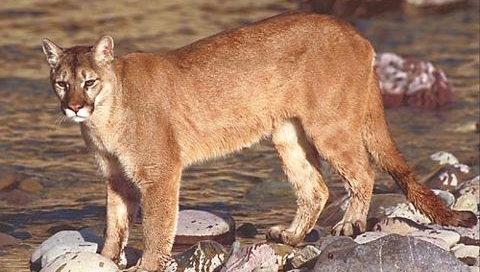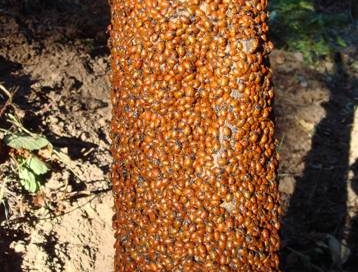Mountain Lions, Forest Fires and 73-Year-Old Women
What’s the most interesting thing that’s happened in your house at night? Our 73-year-old neighbor in Big Sur, California was lying in bed reading at 11:30, and she had just dozed off when a mountain lion crashed THROUGH the glass of her front door, trying to get her pet cat. I’m not making this up. The cat streaked under her bed, with the lion in hot pursuit, and by the time this woman had her senses about her, there was a great tawny rump and tail sticking up beside her from under her bed.
It gets better. She thought it was a neighborhood dog. She smacked it on the rump and yelled for it to get out. The mountain lion, somewhat taken aback, leapt back across the room, perched on a box, and looked at her. At this point, the woman’s husband appeared in the bedroom door (blocking the lion’s only escape), and the lion, unnerved and disoriented now, started coursing around the room looking for a way out, knocking things over and breaking two mirrors. The couple retreated to another room, and the mountain lion immediately vanished into the night.
It was 2008, and our small Big Sur, California community had just survived the Basin Complex forest fire, and strange things happen after large forest fires. This was probably one of them. Huge areas of wilderness had been burned, and the deer, a mountain lion’s main prey, had moved elsewhere in search of food, or perished. The lion was sighted several more times, and so was a cub that was probably hers, and people’s cats were disappearing. The lion had probably lived its life in deep wilderness. In all likelyhood she was displaced, disoriented, desperate, hungry, and—to make it even worse—a mother. It can all add up to a very aggressive personailty. She was probably unfamiliar with human settlements, and this was probably her first encounter with glass (and a pretty unpleasant one, I’m guessing). We were just hoping to somehow make these first human encounters as negative as possible for her, so she’d move on. Otherwise, Department of Fish and Game hunters would have to come into our canyon and kill her.
When you choose to live on the edge of a wilderness, you take on an obligation to co-exist with the elements of nature that drew you there, and it’s a for-better-or-worse contract. You get the babbling brooks and the cute songbirds, and you also get fires, floods and the occaisonal mountain lion. In the wake of this, I have not heard any voices in the canyon demanding indignantly to be made safe, and that’s a community sentiment I’m proud of. We were keeping our pets indoors and hoping the lion moved on. But we knew that she might not. She’d already had several meals. This was working for her.
As for the woman, a long-time resident of Big Sur who works at Esalen Institute, she said she never once felt frightened or threatened, and hoped no one would have to kill the big cat. I’m jealous of her legacy. How many people can say they’ve smacked a mountain lion on the butt?
As for the kitty cat, she escaped unscathed, though she didn’t come out from under the bed for two days.
As for myself, I love nature and I love mountain lions, but I seem not to have the steel nerves of that 73-year-old woman. Lately I find our forest to be a very spooky place at night.
And since this is a Ranger Randy article, here are some interesting facts about mountain lions:
- Statistically, it is about a thousand times less likely that you will be attacked by a mountain lion than that you will be struck by lightning. (That’s a national statistic. I figure my numbers are a bit higher at the moment.)
- They are hugely successful, with a range that extends from the Yukon in Alaska to the southern end of the Andes, and from coast to coast in both Americas, but with this caveat: we exterminated them everywhere east of the Mississippi, and they haven’t recovered yet.
- Probably because of their huge range, they have over 40 names in English alone: Cougar, mountain lion, panther, puma, catamount—it goes on and on.
- They have the largest hind quarters of any cat, even proportionally (and they’re big cats) and it makes them capable of spectacular vertical leaps of up to 18 feet. (That’s from the ground to the roof of a two-story house.) Horizontally they can do 35 or 40.
- They are what’s called a hypercarnivore, meaning that they are purists about eating only meat. Yet they are generalists in their hunting practices, and the meat can take the form of anything from insects up to a moose. In the US, deer are their main prey.
- As with most animals including us, you don’t want to mess with the mothers: they’ve been known to fight off grizzly bears in defense of their young.
- They hiss, growl and purr just like a domestic cat. They also chirp, and whistle.
Now you know.
Episode Two
Chapter two of the mountain lion saga is also a pretty good yarn, but with a sad ending.
Another of our neighbors in Big Sur, California has—or rather had—16 hens and a rooster in a chicken coop. Several days after the above events, when they walked some guests over there to show them the chickens, they looked through the wire into the face of a mountain lion.
From what they could reconstruct later in a calmer state, the mountain lion probably jumped onto the roof of the chicken coop, fell through the wire into it, massacred every chicken there, and then couldn’t get out. However, they didn’t know about this “couldn’t get out” part at that particular moment, and assumed themselves to be seconds away from dismemberment. They retreated quickly into the nearest structure, which was a greenhouse, where, I assume, they looked apprehensively out at the lion and mulled over their situation with suddenly-focussed minds. Finally, one brave soul made a run for an automobile and swung by to pick the others up, and got everyone to the safety to the house. (Safety is a relative term here—this was, after all, almost certainly the same mountain lion that crashed through a glass door into a house in episode one.)
Fish and Game came out, and our neighbors agonized with the officer about what to do. The officer was willing to consider releasing her, but argued that this cougar had picked up some habits that made her dangerous. Relocating the lion was not an option. The California Department of Fish and Game doesn’t do that, and I can think of several good reasons for the policy, the best one being that it seldom results in anything but the death by starvation of the relocated animal. No, they were told, it was release her back into the neighborhood, or shoot her.
There was a two-month-old baby on the property, along with four adults and many more animals. It was not an easy decision, but they decided to put the lion down. The deed was done quickly, with a single shot through the heart.
It was necessary, but Susan and I went home that night feeling saddened, and I was lamenting that we could no longer live in harmony with the creatures around us. Then the ghost of Ed Abbey that lives inside me piped up and said, “What harmony?” Ed Abbey, in case you don’t know him, is a wonderful writer and uncompromising defender of the wild who hated the sentimentalizing of nature, and I had to admit, he spoke the truth. The unsentimental fact is, nobody “lives in harmony” with a mountain lion, including other wild creatures. Even our pre-historic hunter-gatherer ancestors did not, I’m sure, “live in harmony” with them. They were probably killing and being killed, stealing one anothers’ prey and generally getting on each others’ nerves. You can find harmony in those long-ago times, but you have to look a level higher, at the numbers: Our ancestors were few enough that neither species threatened the other in a permanent way. In that sense, there was, if not harmony, at least balance.
So Susan and I decided not to get weepy about a harmony that never existed. We sat down on the deck and recited William Blake’s “Tiger, Tiger Burning Bright” into the woods, and raised a glass to the creature. Adieu, magnificent one!



